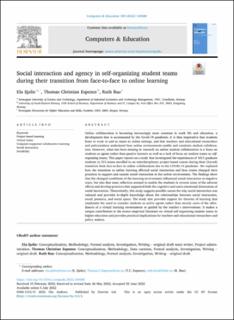| dc.contributor.author | Sjølie, Ela | |
| dc.contributor.author | Espenes, Thomas Christian | |
| dc.contributor.author | Buø, Ruth | |
| dc.date.accessioned | 2022-12-20T08:44:36Z | |
| dc.date.available | 2022-12-20T08:44:36Z | |
| dc.date.created | 2022-09-23T12:55:44Z | |
| dc.date.issued | 2022 | |
| dc.identifier.citation | Sjølie, E., Espenes, T. C. & Buø, R. (2022). Social interaction and agency in self-organizing student teams during their transition from face-to-face to online learning. Computers & Education, 189, Artikkel 104580. | en_US |
| dc.identifier.issn | 0360-1315 | |
| dc.identifier.uri | https://hdl.handle.net/11250/3038729 | |
| dc.description.abstract | Online collaboration is becoming increasingly more common in work life and education, a development that is accentuated by the Covid-19 pandemic. It is thus imperative that students learn to work in and as teams in online settings, and that teachers and educational researchers and policymakers understand how online environments enable and constrain student collaboration. However, what has been missing in research on online student collaboration is a focus on students as agents rather than passive learners as well as a lack of focus on student teams as self-organizing teams. This paper reports on a study that investigated the experiences of 1611 graduate students in 315 teams enrolled in an interdisciplinary project-based course during their (forced) transition from face-to-face to online collaboration due to the COVID-19 pandemic. We explored how the transition to online learning affected social interaction and how teams changed their practices to support and sustain social interaction in the online environment. The findings show that the changed conditions of the learning environment influenced social interaction in negative ways, but also that team reflection seemed to enable the students to reverse some of the adverse effects and develop practices that supported both the cognitive and socio-emotional dimensions of social interaction. Theoretically, this study suggests possible causes for why social interaction was reduced and provides in-depth knowledge about the relationships between social interaction, social presence, and social space. The study also provides support for theories of learning that emphasize the need to consider students as active agents rather than merely users of the affordances of a virtual learning environment or guided by the teacher's interventions. It makes a unique contribution to the scarce empirical literature on virtual self-organizing student teams in higher education and provides practical implications for teachers and educational researchers and policy makers. | en_US |
| dc.language.iso | eng | en_US |
| dc.rights | Navngivelse 4.0 Internasjonal | * |
| dc.rights.uri | http://creativecommons.org/licenses/by/4.0/deed.no | * |
| dc.title | Social interaction and agency in self-organizing student teams during their transition from face-to-face to online learning | en_US |
| dc.type | Peer reviewed | en_US |
| dc.type | Journal article | en_US |
| dc.description.version | publishedVersion | en_US |
| dc.rights.holder | © 2022 The Authors. | en_US |
| dc.source.pagenumber | 12 | en_US |
| dc.source.volume | 189 | en_US |
| dc.source.journal | Computers & Education | en_US |
| dc.identifier.doi | https://doi.org/10.1016/j.compedu.2022.104580 | |
| dc.identifier.cristin | 2054806 | |
| dc.source.articlenumber | 104580 | en_US |
| cristin.ispublished | true | |
| cristin.fulltext | original | |
| cristin.qualitycode | 2 | |

